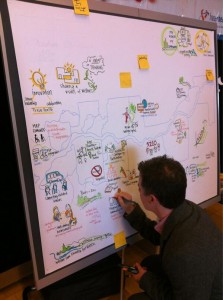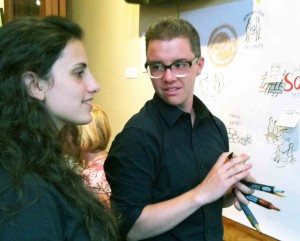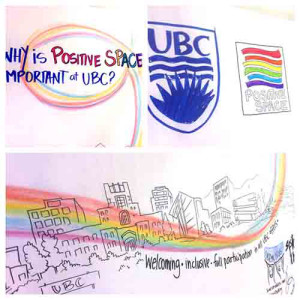Engage visually and start with a juicy question
Thinking about hosting an event where you want people to share their thoughts – and see the conversation emerge visually? As a graphic facilitator, my tip is to engage visually and start with a juicy question.
 One of my favorite resources is a book called The Art of Powerful Questions. This short yet comprehensive guide is written by Eric Vogt, Juanita Brown and David Isaac and is available in the World Cafe store. Their list of questions are a great launching-off point to make meaning. It’s very useful for visual thinking.
One of my favorite resources is a book called The Art of Powerful Questions. This short yet comprehensive guide is written by Eric Vogt, Juanita Brown and David Isaac and is available in the World Cafe store. Their list of questions are a great launching-off point to make meaning. It’s very useful for visual thinking.
When I’m invited to events as a graphic facilitator, I listen and draw to support organizations in doing their best work – from dialogue, to strategic planning, to engagement. Often I’m a silent partner, listening and drawing the speakers and sessions. Here’s what I look like busily working away on a health map (photo by @silaspur). I’m in the drawing zone – and that’s the back of my head: I come up for air at breaks with everyone else.
But graphic facilitation can also be a deeply engaging process. When I’m invited to engage with participants one-on-one, I facilitate asking participants questions and then drawing what they say. I seek permission to synthesize and draw. Participants might want to answer 1 question or more – I don’t pressure and take direction from them. Together, the visual summary is built directly from their words. Here’s is a photo of me by @codev working one-on-one. (I look a bit funny, I think this is my concentrating face.)
 In either situation, it’s a good question that can hook someone into the activity, and then help us go somewhere meaningful.
In either situation, it’s a good question that can hook someone into the activity, and then help us go somewhere meaningful.
Vogt, Brown and Isaac define three types of questions: 1) Focussing collective attention, 2) Connecting and finding deeper insight, and 3) Forward movement. Today I’m selecting and adapting three examples under each category that have been successful for me. Their list is much longer, and I encourage you to read the book for the full set.
Focusing Collective Attention
- What’s the most important part of [this gathering] for you?
- What brings you here today?
- For you, what is the intention of this [campaign] – what’s the Big Why?
Connecting and Finding Deeper insight
- What’s emerging for you today?
- Can you describe a moment that stands out for you?
- What has been your major learning/ insight / discovery so far working with [x group]?
Forward Movement
- What could happen [here] that would enable us to feel fully engaged and energized?
- How can we support each other in taking the next steps [towards our mission statement]?
- What conversation can we start that creates new possibilities [for our stakeholders]?
The UBC for the Diversity and Equity office hosted an event to celebrate their Positive Space campaign. We started with a broad question: Why is positive space important at UBC? It’s clear and direct. It’s also very broad. So when people came up to me to talk, I used these juicy questions from my toolbox to help draw out (okay, couldn’t resist the pun) their thoughts.
The visual format plus a good question gets amazing results. Good questions help people go a bit deeper. Sometimes this means more personal, or just more thoughtful. And it engages those who prefer smaller conversations rather than big groups, so there’s also a different reflection of voices.
Graphic facilitation with interviewing works almost everywhere – I’ve used it at open houses, events, public engagement, staff recognition … and no drawing skills required from the participants. It’s very rewarding to have someone look at the visual summary and say, “yes, that’s exactly what I meant.”
